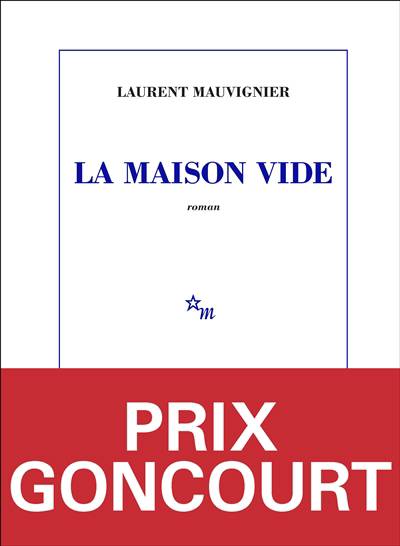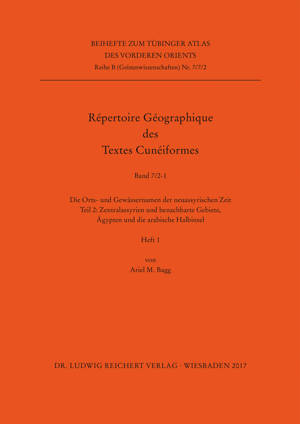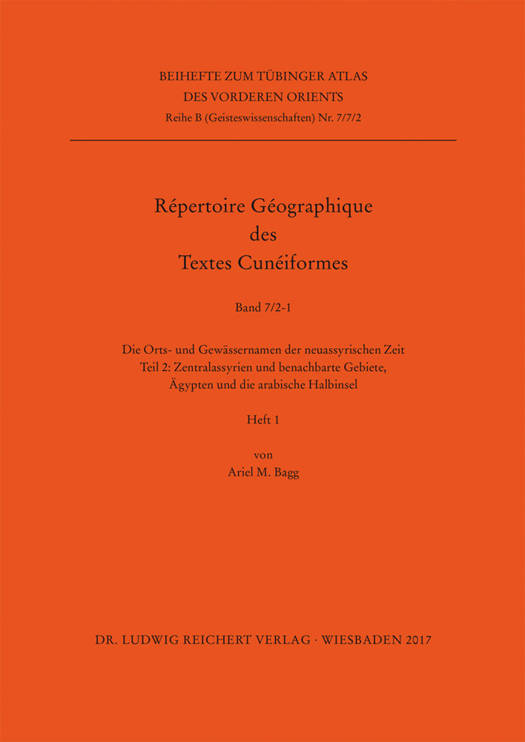
- Retrait en 2 heures
- Assortiment impressionnant
- Paiement sécurisé
- Toujours un magasin près de chez vous
- Retrait gratuit dans votre magasin Club
- 7.000.0000 titres dans notre catalogue
- Payer en toute sécurité
- Toujours un magasin près de chez vous
Die Orts- Und Gewassernamen Der Neuassyrischen Zeit
Teil 2. Zentralassyrien Und Benachbarte Gebiete, Agypten Und Die Arabische Halbinsel
Ariel M Bagg
165,45 €
+ 330 points
Format
Description
English summary: Historical geography is one of the most important disciplines which allow a reconstruction of the history of the Ancient Near East. There are principally the cuneiform sources which open the access to the numerous attested geographical names. The toponyms from these sources were collected and commented in the series Repertoire Geographique des Textes Cuneiformes (RGTC) published in the frame of the Tubinger Atlas des Vorderen Orients (TAVO). Fourteen volumes already published in this series have become, together with the corresponding TAVO-historical maps, an important research tool in the field of the historical geography of the Ancient Near East. The final volume of the series (RGTC 7) is about the extensive (approx. 3450) place and river names from the Neo-Assyrian texts (10th to 7th cent. BCE) and was conceived a tripartite work. The present two-volume set is the second part of the Neo-Assyrian toponyms for the above mentioned series (RGTC 7/2). It comprises approx. 1500 toponyms from the Assyrian heartland and neighbouring areas (the Transtigridean region, the Middle Euphrates, the Northern Jezireh, the Habur-Basin, the Eastern Jezireh and Northern Mesopotamia), as well from Egypt and the Arabian peninsula. The first part was published by the author in 2007 and dealt with the Levant (RGTC 7/1). The third and last part (RGTC 7/3) is in preparation and will cover the Eastern regions of the Assyrian empire and Babylonia.The arrangement of the book follows the earlier volumes of the series. The material comprises all the published, non-literary sources from the Neo-Assyrian period, namely royal inscriptions, letters, legal and administrative texts, treaties, royal grant and decrees, astrological reports, and historiographical texts. Following Kh. Nashef's RGTC 5 (1982), all the texts after 934 BCE have been considered. The alphabetically arranged collection of place names is divided as usual in the categories "place names" and "watercourses". The main criterion for the arrangement of the attestations are the different spellings. Within the same spelling the arrangement of the attestations follows chronological and typological criteria. The attestations are followed by a commentary concerning the identification of the place name with a discussion of the relevant secondary literature. As in the volumes RGTC 8 and RGTC 12/2, the toponyms are ordered according to their linguistic provenance. Comprehensive indices, among them a register of modern place names as well as a register of the mentioned Old-Aramaic, Biblical, Classical, and Phoenician toponyms, complete the book. Two enclosed maps show most of the identified places. German description: Die historische Geographie ist eine der wichtigsten Disziplinen, die eine Rekonstruktion der Geschichte des Alten Orients ermoglichen. Es sind uberwiegend die Keilschriftquellen, die den Zugang zu den zahlreichen Ortsnamen erschliessen. Eine grosse Anzahl einschlagiger Orts- und Gewassernamen ist als kommentierte Materialsammlung in der Reihe Repertoire Geographique des Textes Cuneiformes (RGTC) erfasst. Es liegen bisher 14 Bande bzw. Teilbande vor (1974-2007), die nach chronologischen und regionalen Kriterien gegliedert sind. Sie sind ebenso wie die Karten des TAVO ein wichtiges Hilfsmittel fur die Erforschung der Historischen Geographie des Alten Orients. Der abschliessende Band der Reihe (RGTC 7) ist den umfangreichen (ca. 3450) Orts- und Gewassernamen der neuassyrischen Texte (10.-7. Jh. v. Chr.) gewidmet und wurde als dreiteiliges Werk konzipiert. Der vorliegende Band (RGTC 7/2), bestehend aus zwei Heften, stellt den zweiten Teil dar und umfasst ca.1500 Toponyme aus den folgenden Regionen: das Kernland Assyriens, das Osttigrisgebiet, der Mittlere Euphrat, die nordwestliche Gazira, das ?abur-Gebiet und die ostliche Gazira und Nordmesopotamien (namlich das Gebiet an und um dem Oberen Tigris mit dem Murat-Su als nordliche und dem Euphrat als westliche Grenze). Ausserdem wurden die arabische Halbinsel und Agypten berucksichtigt. Im 2007 publizierten ersten Teil (RGTC 7/1) wurde die Levante behandelt. Der letzte Teil (RGTC 7/3), die in Vorbereitung ist, wird die ostlichen Gebiete und Babylonien umfassen.Die Darbietung des Materials schliesst sich an fruhere RGTC-Bande an. Es umfasst alle Texte der neuassyrischen Zeit, soweit sie nicht als "literarisch" einzustufen sind, d. h. Konigsinschriften, Briefe, Rechts- und Veraltungsurkunden, Vertrage, konigliche Erlasse, astrologische Berichte und historiographische Texte. Anschliessend an RGTC 5 (1982) von Kh. Nashef werden alle Texte von 934 v. Chr. bis zum Untergang des neuassyrischen Reich berucksichtigt. Orts- und Gewassernamen werden alphabetisch und unter Berucksichtigung der unterschiedlichen Keilschriftorthographie aufgefuhrt. Daruber hinaus erfolgt die Anordnung der Belege nach chronologischen und typologischen (Art der Quelle) Kriterien. Es folgen Angaben zur Lokalisierung unter Berucksichtigung der relevanten Sekundarliteratur. Wie in den Banden RGTC 8 und RGTC 12/2 werden die Ortsnamen nach ihrer sprachlichen Herkunft zugeordnet. Umfangreiche Register, darunter ein Verzeichnis der modernen Ortsnamen sowie der erwahnten aramaischen, biblischen, klassischen und phonizischen Toponyme schliessen den Band ab. Zwei beigefugte Karten veranschaulichen die meisten Lokalisierungsvorschlage.
Spécifications
Parties prenantes
- Auteur(s) :
- Editeur:
Contenu
- Nombre de pages :
- 934
- Langue:
- Allemand
- Collection :
Caractéristiques
- EAN:
- 9783954902620
- Date de parution :
- 28-09-17
- Format:
- Livre broché
- Format numérique:
- Trade paperback (VS)
- Dimensions :
- 170 mm x 239 mm
- Poids :
- 1814 g

Seulement chez Librairie Club
+ 330 points sur votre carte client de Librairie Club
Les avis
Nous publions uniquement les avis qui respectent les conditions requises. Consultez nos conditions pour les avis.








